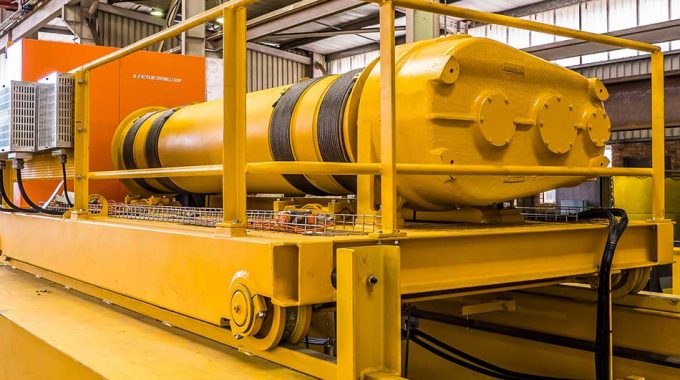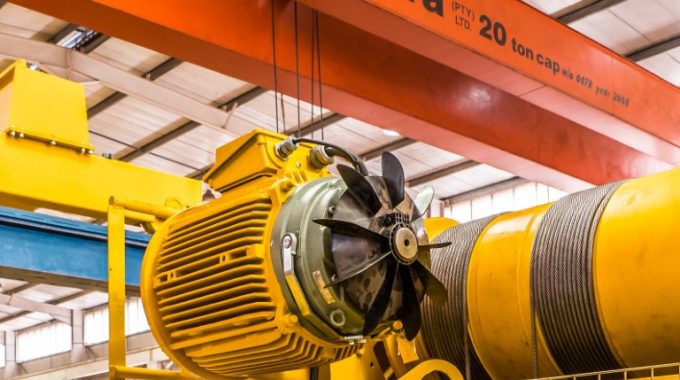HORSES FOR COURSES – ARE BIGGER WAREHOUSES WORTH IT?
Factories and warehouses are wider than ever, and existing buildings are being extended to make them longer. Both trends beg questions about increases in productivity – are they in proportion to the higher costs of construction?
Crane manufacturer Condra claims to provide at least part of the answer, supplying the overhead travelling machines that service these larger buildings.
Though the company still delivers many cranes with traditional spans of around 17 metres, there are orders for an increasing number of double-girder machines greater than 25 metres in span, and managing director Marc Kleiner says that he has in recent years seen buildings measuring as much as 26 metres by 28 metres served by a single crane.
His opinion is that the economy of building factories of such a size is debatable, because as the span of the overhead crane increases to match factory width, so too does the cost of the factory structure needed to support its weight.
“And the crane itself also becomes more expensive,” Kleiner added.
“For example, the 3-ton girder needed for a 17-metre span increases in weight to 12 tons when the span becomes 25 metres – a fourfold weight increase to service a 47 percent increase in factory width – and additional power is also needed to move the heavier crane.”

In the case of factory extensions serviced by a second overhead crane, a similar question hangs over whether the intended increases in productivity are actually achieved, because cranes operating in tandem can lead to production logjams.
Kleiner explained:
“The thinking is that you put up the initial building which is, say, a two-bay layout, and incorporate planning to extend it at a later date and install a second crane to service an additional two bays.
“But what often happens is that goods in Bay One cannot be moved to Bay Three because of the second crane working in Bay Two,” he said.
Turning to factories with more modest widths, Kleiner said that single-girder overhead cranes are often a cost-effective alternative to the double-girder ideal.
In Bulgaria, Condra’s subsidiary there has recently delivered single-girder cranes to an engineering company (a 5-ton machine), and to a steel trading company (two machines with capacities of 5 tons and 3,2 tons). Spans of these cranes range between 11 and 13,8 metres. More single-girder machines are under manufacture.
Kleiner emphasised the functional design of this type of crane:
“The single-girder design is both durable and robust, and is an effective solution in standard factory applications.
“Of course, the double-girder design provides the advantages of greater stability, lift precision and lifetime durability, but these benefits come at a higher initial price that is later justified many times over by a much extended useful life.
“A tight budget may therefore dictate consideration of the single‑girder design, which in many cases will be adequate.”
Kleiner said that single-girder designs were usually fitted with Titan short-headroom (SH) series hoists, underslung to maximise vertical lift by absorbing the dimensions of motor and cable drum into the space of the girder depth.
SH-Series hoist profiles are some 20 percent less than that of other underslung hoist models.
Titan hoists lift a maximum load of 16 tons, and incorporate refinements such as automatic rope tensioning, smooth travel, built-in load limiter, standardised direct drive and universal carriage.
Design of all Condra cranes, both single-girder and double-girder, takes place at Condra’s Gosforth Park factory outside Johnnesburg, where design teams examine the application and compare the suitability of the two alternatives.
Manufacture to specification is carried out using selected components from some 250 sub‑assemblies, the main ones being hoists, drives, end-carriages, brakes, gearboxes and motors.
Hoists are assembled from standard Condra parts, and fitted with either hooks, grabs, magnets, ladles, buckets or spreaders according to requirement.
All manufacture is carried out in accordance with the quality management standards of ISO 9001:2015.
Crane manufacturer Condra claims to provide at least part of the answer, supplying the overhead travelling machines that service these larger buildings.
Though the company still delivers many cranes with traditional spans of around 17 metres, there are orders for an increasing number of double-girder machines greater than 25 metres in span, and managing director Marc Kleiner says that he has in recent years seen buildings measuring as much as 26 metres by 28 metres served by a single crane.
His opinion is that the economy of building factories of such a size is debatable, because as the span of the overhead crane increases to match factory width, so too does the cost of the factory structure needed to support its weight.
“And the crane itself also becomes more expensive,” Kleiner added.
“For example, the 3-ton girder needed for a 17-metre span increases in weight to 12 tons when the span becomes 25 metres – a fourfold weight increase to service a 47 percent increase in factory width – and additional power is also needed to move the heavier crane.”

Very wide-span crane nearing completion in Condra’s Johannesburg factory
In the case of factory extensions serviced by a second overhead crane, a similar question hangs over whether the intended increases in productivity are actually achieved, because cranes operating in tandem can lead to production logjams.
Kleiner explained:
“The thinking is that you put up the initial building which is, say, a two-bay layout, and incorporate planning to extend it at a later date and install a second crane to service an additional two bays.
“But what often happens is that goods in Bay One cannot be moved to Bay Three because of the second crane working in Bay Two,” he said.
Turning to factories with more modest widths, Kleiner said that single-girder overhead cranes are often a cost-effective alternative to the double-girder ideal.
In Bulgaria, Condra’s subsidiary there has recently delivered single-girder cranes to an engineering company (a 5-ton machine), and to a steel trading company (two machines with capacities of 5 tons and 3,2 tons). Spans of these cranes range between 11 and 13,8 metres. More single-girder machines are under manufacture.
Kleiner emphasised the functional design of this type of crane:
“The single-girder design is both durable and robust, and is an effective solution in standard factory applications.
“Of course, the double-girder design provides the advantages of greater stability, lift precision and lifetime durability, but these benefits come at a higher initial price that is later justified many times over by a much extended useful life.
“A tight budget may therefore dictate consideration of the single‑girder design, which in many cases will be adequate.”
Kleiner said that single-girder designs were usually fitted with Titan short-headroom (SH) series hoists, underslung to maximise vertical lift by absorbing the dimensions of motor and cable drum into the space of the girder depth.
SH-Series hoist profiles are some 20 percent less than that of other underslung hoist models.
Titan hoists lift a maximum load of 16 tons, and incorporate refinements such as automatic rope tensioning, smooth travel, built-in load limiter, standardised direct drive and universal carriage.
Design of all Condra cranes, both single-girder and double-girder, takes place at Condra’s Gosforth Park factory outside Johnnesburg, where design teams examine the application and compare the suitability of the two alternatives.
Manufacture to specification is carried out using selected components from some 250 sub‑assemblies, the main ones being hoists, drives, end-carriages, brakes, gearboxes and motors.
Hoists are assembled from standard Condra parts, and fitted with either hooks, grabs, magnets, ladles, buckets or spreaders according to requirement.
All manufacture is carried out in accordance with the quality management standards of ISO 9001:2015.


